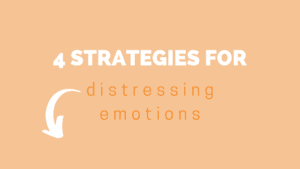Distressing emotions can creep up on us rather quickly. Sometimes there is a trigger, such as unexpected piece of news, or getting into verbal conflict with someone. Other times, it may not feel as though there is a clear trigger, such as when a panic attack sets in. When we experience distressing emotions, what can we do? In this article I will outline four ways to manage distressing emotions using Cognitive Behavioral Therapy (CBT) and related approaches.
Please note that if you are experiencing thoughts of hurting yourself, someone else, or suicide please stop reading this article and use a hotline to gain immediate assistance. Click here for a list of international crisis numbers.

Make a Plan
Preparation, even for the unexpected, can add a layer of security for when the unexpected happens. To make an emotional plan, take a piece of paper that you can keep on you (such as in your wallet) or write a note on your phone.
First, you will write down safe places you can go to when you begin to feel distressed. Perhaps it will be going to your home, taking a bathroom break if you are out in public, or sitting in your car (do not drive- pull over if you are driving when the distressing emotions set in.)
Second, you will write down what breathing exercises or distractions work for you. From listening to music, to meditation, to watching videos on your phone, there are multiple strategies that can be implemented. Do you know which ones work well for you or that you would like to try? I usually suggest listing out at least one breathwork strategy and one distraction strategy.
Third, you will write down at least one (but I recommend at least two) people you can call or talk to. By having two people on your list, you have a backup in case one is unavailable. Make sure to choose people who uplift you and you have a supportive, balanced relationship with. There is no room for energy vampires here!
Lastly, write down a remind that you will contact your therapist and let them know what happened so you can discuss it at your next session. At online-therapy.com, for example, you have access to a message board where you can inform your provider when distressing emotions happen.
Example:
Putting it all together, here is just one (of limitless!) examples of what your plan may look like:
First:
If I am outside, I will sit in my car, pulled over safely. If I am home, I will go to my bedroom, where I feel most comfortable.
Second:
I will practice a five minute meditation and/or listen to music.
Third:
I will call my Mom. If she does not pick up, then I will try my sister.
Fourth:
I will send a message to my therapist to let them know what happened and how I feel.
By having a plan in place, even if it is hard to remember in the moment, you will have all the steps written down to follow.
Assess the Situation
There are multiple ways to assess what is happening when you are feeling upset. Today, I am going to discuss this type of analysis through what is called a perceived versus actual threat analysis. This is often used in Cognitive Behavioral Therapy to decide to what extent do your thoughts and feelings about a situation match the actual threat of the situation itself.
First, you will assess how much threat a situation feels like to you in the moment on a scale of 1-10. Chances are, if you are feeling distress in the moment, you will rate the perceived threat as high, or on the high-end.
From there, you are going to assess how much of an actual threat is happening on a scale of 1-10. This may be challenging at first, but with practice, especially initial practice with a therapist, this strategy becomes much easier. A good way to learn this strategy is to break down actual threat into different categories such as physical violence threat, financial threat, and emotional security threat. Not receiving a promotion at work, for example, would be a zero on physical violence threat, but would be placed somewhere on the financial threat scale.
This strategy is particularly helpful when something unexpected happens or we have interpersonal conflict with others.
Evaluate Through Questions
Asking Questions is a skill utilized in CBT where you ask yourself a series of prompting to questions to help evaluate your thoughts when you feel negative emotions. You can ask yourself:
- What is the evidence for my thoughts right now?
- Is there evidence against my thoughts right now?
- What is the worst-case scenario right now? If that were to happen, how would I handle it?
- What is the best case scenario?
- What is a likely scenario or what emotional conclusions can I draw from the other questions?
Through this assessment, now only are you evaluating your thoughts, but you are also bringing yourself back into the present moment again.
Movement
Movement is a fantastic way to handle the physical symptoms that can come along with distressed emotions. Even if it feels hard to get your body going, the level of stress that is building up in your body will respond well to physical movement to exert some of that energy. The amount of movement and the time it takes to feel better will vary from person to person, but some movement is better than none.
If you can’t, or are physically unable to engage in a workout routine or play sports, that’s totally fine- we don’t need to go there when things feel really distressing. Can you go for a brisk walk? Or if you are home and want to stay there can you do repetitive motions such as jumping jacks, pacing, or going up the stairs?
Keep moving your body, or changing up the different motions that you are doing. Try and go for at least ten minutes, but the longer you are able to keep your body moving, the better it is to expel the stress and anxiety that is building up in your body in the moment.
Putting it all Together
We have now discussed four different strategies that can help when you feel distress. Now I want to talk about ways that you can actually put all four strategies together. First, at a time when you are feeling calm you can put together your distress plan as I mentioned in the first strategy. This can also be created with your therapist during one of your sessions. Then, when you begin to feel distressed, you can implement the plan you made.
On top of the things listed out in the plan, can you also move your body like in the fourth strategy? Once some of the physical symptoms you are feeling while experiencing distressing emotions occur start to alleviate, you can begin to assess the situation, your feelings, and your thoughts. This is where strategies two and three come in. You can even implement this while talking to someone as (as part of your distress plan). For example, the person you talk to may help you objectively decide on what is the actual threat of a situation.
Connecting with a Therapist
I also want to remind you that just as I said a few times in this article, you can also work with a therapist to come up with some of these plans tailored specific to your needs as an individual. Here at online-therapy.com, our providers specialize in using Cognitive Behavioral Therapy for various diagnoses and needs. We would love to help you feel prepared to handle different life situations and emotions!




Leave A Comment